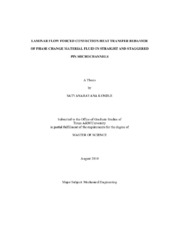| dc.description.abstract | Microchannels have been studied extensively for electronic cooling applications ever since they were found to be effective in removing high heat flux from small areas. The rate of heat removed using microchannels depends on many factors including the geometry shape, solid and fluid materials used, and surface roughness, among others. Many configurations of microchannels have been studied with various materials and compared for their effectiveness in heat removal. However, there is little research done so far in using Phase Change Material (PCM) fluids and pin fins in microchannels to enhance the heat transfer.
PCM fluids exhibit greater heat transfer when the phase change material undergoes liquid-to-solid transformation. Staggered pins in microchannels have also shown higher heat removal characteristics because of the continuous breaking and formation of the thermal and hydrodynamic boundary layer; they also exhibit higher pressure drop because pins act as flow obstructers.
This paper presents numerical results of circular, square, straight rectangular microchannels with various aspect ratios (1:2, 1:4 and 1:8), and rectangular microchannels with two characteristic staggered pins (square and circular, fixed height with no variation in aspect ratio). The heat transfer performance of a single phase fluid and PCM fluid in all of these microchannels and the corresponding pressure drop characteristics are also presented.
An effective specific heat capacity model was used to account for the phase change process of PCM fluid. Comparison of heat transfer characteristics of single phase fluid and PCM fluid are presented for all the geometries considered. Among the straight microchannels, 1:8 geometry was found to have the highest Nusselt number. The use of PCM fluid in straight microchannels increased the Nusselt number by 3-7 percent compared to the single phase fluids. Among the staggered pin microchannels, circular pins were found to be more effective in terms of heat transfer by exhibiting higher Nusselt number. Circular pin microchannels were also found to have lower pressure drop compared to the square pin microchannels. Overall, for all the geometries considered, it was found that the PCM fluid enhances the heat transfer compared to the SPF fluid. | en |


